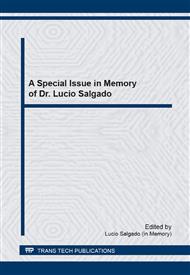[1]
American Petroleum Institute. Recommended practice for testing well cements. API RB 10B, Dallas, (1997).
Google Scholar
[2]
E. B. Nelson: Well cementing. Houston: Schlumberger Educational Services, (1990).
Google Scholar
[3]
P. C. Hewlett: Lea's chemistry of cement and concrete. (Burlington: Elsevier, 2004).
Google Scholar
[4]
P.K. E Mehta and P.J.M. Monteiro: Concreto: estrutura, propriedades e materiais. (Pini São Paulo, 1994).
Google Scholar
[5]
J.H.O. Nascimento: Adição de poliuretana não iônica a cimento Portland Especial para cimentação de poços de petróleo. Mestrado (Dissertação). Natal, 2006. Universidade Federal do Rio Grande do Norte. (UFRN). (RN).
DOI: 10.22239/2317-269x.01494
Google Scholar
[6]
L. B. Silva, J.H.O. Nascimento, A.E. Martinelli, D.M.A. Melo and F.M. Lima: 17° Congresso Brasileiro de Ciência dos Materiais (CBECIMAT). Foz do Iguaçu 15-19 de Novembro 2006. Procceding.. Foz do Iguaçu 2006. (PR).
DOI: 10.21041/conpat2019/v2pat260
Google Scholar
[7]
Associação Brasileira De Normas Técnicas. Cimento Portland destinado à cimentação de poços petrolíferos. Rio de Janeiro: ABNT, 1993. (NBR 9831).
Google Scholar
[8]
U.T. Bezerra: Compósitos Portland-biopolímero para cimentação de poços de petróleo. Doutorado (Tese). Natal, 2007. Universidade Federal do Rio Grande do Norte. (UFRN/EM). (RN).
DOI: 10.22239/2317-269x.01494
Google Scholar
[9]
P.K. E Mehta and P. J. M. Monteiro: Concreto: microestrutura, propriedades e materiais. (Pini São Paulo, 2008).
Google Scholar
[10]
E.P. Lima And P. R. L. Helene, Influência do volume de pasta na zona de transição pasta/agregado com relação às propriedades mecânicas e de durabilidade do concreto. São Paulo, 2001. 17 p. (BoletimTécnico, 270).
DOI: 10.1590/s1678-86212009000400522
Google Scholar
[11]
NISTIR 5755. Guide for X-ray powder diffraction analysis of Portland cement and clinker. Gaithersburg: National Institute of Standards and Technology, (1996).
Google Scholar
[12]
H.F.W. Taylor: Cement chemistry. (Thomas Telford 2 ed. New York, 2003).
Google Scholar
[13]
A.K.C. Nóbrega: Formulação de pastas cimentícias com adição de suspensões de quitosana para cimentação de poços de petróleo. Doutorado (Tese). Natal, 2007. Universidade Federal do Rio Grande do Norte. (UFRN/EM). (RN).
DOI: 10.22239/2317-269x.01494
Google Scholar


